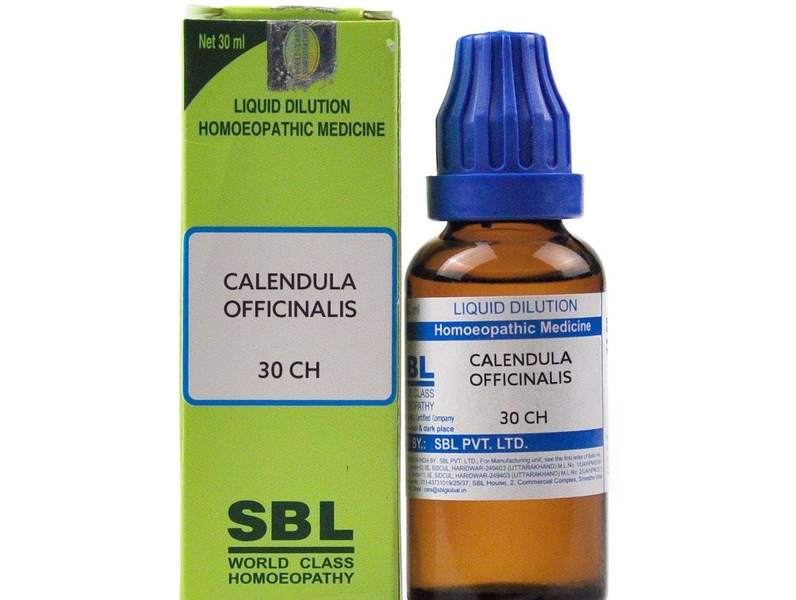- Remarkable healing agent in excessively painful, open, torn, cut, lacerated, ragged or suppurating wounds
-
Prevents suppuration, promotes healthy granulation of tissues and
rapid healing by first intention - Pain is excessive and out of all proportion to injury
- Heartburn with horripilation
- Ulcers painful, as if beaten
Source: Mineral Kingdom
Synonyms: Marigold
Family: Compositae
Prover: Dr Franz in 1838
Duration of Action: Short acting remedy
Miasmatic Background: Psora
Temperament: Nervous
Diathesis: Ersipelatous
Thermal Relationship: Neither chilly nor hot
Introduction and History: It was in common use as a medicine in the sixteenth century. It is a great homeopathic antiseptic for wounds. It can be used externally with wonderful results. It is a homeopathic surgical and first aid for such type of conditions. The name Calendula is derived from ‘calends’ which means the first day of the month. This flowers blooms on the first day of the month or atleast once a month.
Habit and Habitat: It is native of France and southern Europe. It has been cultivated in the gardens as an ornamental flower. It is an annual herb. The leaves are toothed, spatulated and oblanceolate. The flowers are yellow or orange in colour, large, terminal and solitary.
Preparation and Parts Used: Mother tincture is prepared from the fresh flowering tops and leaves.
Ailments From: Post-surgical injury, loss of blood, rupture of muscles and tendons, traumatic neuroma, old neglected offensive wounds.
Seat of Action (Pharmacodynamics): Nerves, skin, tendons, scalp, muscles, etc.
Active Principles (Chemical Constituents): It contains traces of volatile oil, a bitter principle and calendulin which is a tasteless substance.
Physio-pathological Changes (Pathology)
- It acts as a haemostatic and promotes healthy granulation; prevents excessive suppuration and disfiguring scars.
- It acts on muscles, tendons, nerves and produces a condition similar to lacerated injuries.
- It acts on skin and produces a tendency to erysipelas. It has remarkable power to produce local exudation.
Characteristic Mental Symptoms (Psychology)
- Extremely nervous, easily frightened.
- Feels weight on brain, tearing headache.
Characteristic Physical Guiding Symptoms
Injury: An excellent remedy for injuries, like surgical cuts, clean cuts, lacerated or suppurating wounds.
Skin: Has a constitutional tendency to erysipelas.
Haemostatic: It is a very good haemostatic for tooth extraction.
Cancer: It is very well used as an intercurrent remedy for cancer cases.
Pain: Intensity of pain is out of all proportion to injury due to the involvement of nerves.
Deafness: Deafness, worse in damp surroundings and with an eczematous condition. Hears best on a train, and distant sounds.
Warts: Warts at the external os, uterine hypertrophy, chronic endocervicitis.
Eyes: Injuries of eyes, which tend to suppuration after operations.
Cough: Cough with green expectoration, hoarseness, with distention of inguinal ring.
Fever: Fever with coldness, great sensitiveness to open air, skin feels warm to touch. Heat in the evening.
Coryza: Coryza in one nostril, with much green discharge.
Hunger: Hunger immediately after nursing. Heartburn with sensation of nausea in the chest.
Laceration: Lacerations during labour, rupture of muscles or tendons. Wounds penetrating articulations with loss of synovial fluids.
Ulcers: Ulcers irritable, inflamed, sloughing, varicose, painful as if beaten with excessive secretion of pus.
Important Characteristic Features
Injury: It is a very good medicine for surgeries, amputations, lacerated wounds, during labour, fracture of bones, clean cut injuries, extraction of teeth, etc. External wounds are with or without loss of substance, for post-surgical WOUNDS, torn and jagged looking wounds; it promotes healthy granulation and prevents excessive suppuration and disfiguring scars. It is of special use in such injuries as gunshot wounds.
It is an invaluable remedy in gynaecological practice. It is used for all cases of loss of soft parts, rupture of muscles or tendons, wounds penetrating articulation with loss of synovial fluids, laceration and perineal tear during labour. Patient becomes exhausted from loss of blood. It is a good remedy for lacerations and perineal tears during labour.
Pain is excessive; idiopathic and traumatic neuroma. It is an excellent remedy for old, neglected, offensive injuries and wounds; also for gangrenous conditions.
General Modalities
Aggravation: In damp, heavy and cloudy weather.
Amelioration: By rest
Remedy Relationships
Complementary: Hep.
Follows well: Ars.
Antidotes: Arn, Chel.
Potency: 3x, 6x, 12x, 30, 200, 1000.
Dosage: It acts well in lower as well as in higher potencies.
Repetition: Bears repetitions very well.
Therapeutic Value: Abscesses, Bleeding, Burns, Carbuncles, Chilblains, Eye inflammation, Gangrene, Injury, Post-surgical effects, Rupture of tendons and muscles, Suppuration, Ulcers, Wounds.
Note: Hot Calendula fomentations are better in case of abscesses. Also hot Calendula lotion is generally preferable to a cold one.
Ask A Doctor
You can now consult our well qualified homeopathic doctor for homeopathic treatment of any kind of disease. The consultancy fee is only Rs 200/- . Post making the payment you will be asked about the disease and the symptoms of your disease. Based on your problem, the doctor will instruct you with the name of the medicine and the method of having the medicine. You can make the payment via Paytm App or your debit card. For more inquiry contact on the WhatsApp number - +919006242658


Comments are closed, but trackbacks and pingbacks are open.